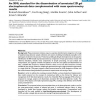BMCBI
2011
13 years 8 months ago
2011
Background: Since its inception, proteomics has essentially operated in a discovery mode with the goal of identifying and quantifying the maximal number of proteins in a sample. I...
BMCBI
2010
13 years 11 months ago
2010
Background: The purpose of this manuscript is to provide, based on an extensive analysis of a proteomic data set, suggestions for proper statistical analysis for the discovery of ...
BMCBI
2004
14 years 1 months ago
2004
Background: Many proteomics initiatives require a seamless bioinformatics integration of a range of analytical steps between sample collection and systems modeling immediately ass...
NAR
2008
14 years 1 months ago
2008
Despite the growing volumes of proteomic data, integration of the underlying results remains problematic owing to differences in formats, data captured, protein accessions and ser...
BMCBI
2008
14 years 1 months ago
2008
Background: A goal of proteomics is to distinguish between states of a biological system by identifying protein expression differences. Liu et al. demonstrated a method to perform...
BMCBI
2008
14 years 1 months ago
2008
Background: Pancreatic cancer is the fourth leading cause of cancer death in the United States. Consequently, identification of clinically relevant biomarkers for the early detect...
BIB
2008
14 years 1 months ago
2008
Proteomics, the study of the protein complement of a biological system, is generating increasing quantities of data from rapidly developing technologies employed in a variety of d...
BIBE
2008
IEEE
14 years 8 months ago
2008
IEEE
—The post-genomic era is characterized by the rapid data accumulation leading to unwieldy and large volumes of biological data. The proteomics results (large sets of identified p...
0
posts
with
0
views
0
views
A biochemist and cell biologist using proteomic approaches to investigate mechanisms of cell adhesion.





